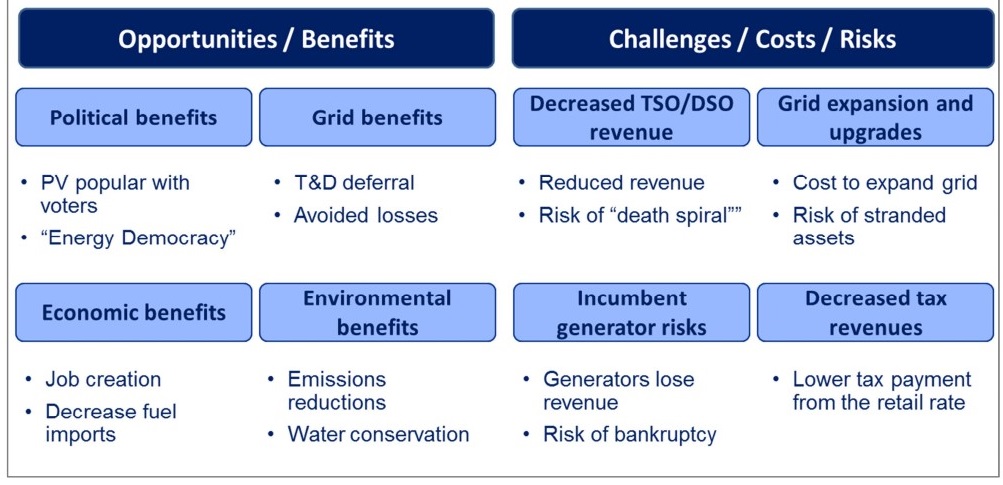Menu
The deployment of renewable energy (RE) in ASEAN in the last eight years has shown a significant increase with total additional capacity of 28 GW. According to the 4th ASEAN Energy Outlook (AEO4) , RE in the power sector will have an average growth of 5.6% between 2013 and 2035. In the Business as Usual (BAU) scenario, the total installed power capacity will reach a value of 152 GW, generating around 392 TWh of electricity in 2035. Solar PV is predicted to reach around 10 GW in 2035 from the current capacity of almost 2 GW. In the last 8 (eight) years, the ASEAN region witnessed a remarkable growth in solar photovoltaic (PV) deployment with the compound annual growth rate of 62%.
Renewables have reached ‘socket parity’
Socket parity is defined as the levelised cost of electricity (LCOE) of renewable is equal to or less than the average price the consumer is paying to the distribution utility.
The cost of renewables, especially solar PV in the global market has declined rapidly over the past few years. The lowest-cost project proposal of utility-scale solar PV in 2016 has been reported as low as USD 0.03 per kilowatt-hour (kWh). Medium and small-scale solar PV systems, in general, are most often installed on the rooftops of residential and commercial buildings. Many countries, including in ASEAN region are reaching to the point where it is in the economic self-interest of individual households and private businesses to install solar PV technology. Based on the LCOE study conducted by ACE, to some extent, small, medium and large scale solar PV technologies have reached socket parity in Malaysia, the Philippines and Singapore.
Net Metering and Energy ‘Prosumers’ in ASEAN
The term “prosumers” refers to consumers who also produce commodities or services.
For major cities, a prosumer—a consumer of electricity who also produces it and can sell it back to the grid, often through a rooftop solar PV system—could be an essential element in meeting the growing needs of electricity. In ASEAN, some Member States like Malaysia, Indonesia, the Philippines and Singapore have applied the net-metering, where prosumers could export and sell their excess power to the grid.
The Government of Malaysia has just launched the net energy metering (NEM), allowing eligible consumers to install a solar PV system primarily for own use and to export or sell the excess energy to the grid . The excess energy will receive credit in Ringgit Malaysia to be used in offsetting part of the electricity bill provided by utility companies.
In Singapore, for low tension, non-contestable consumers with less-than-1-megawatt embedded solar PV systems, the solar energy produced is first offset by the consumption of those premises. Should there be excess solar energy to be exported back to the grid, the consumers will receive payment (the prevailing low-tension electricity tariff minus grid charge) from utility company by way of credit adjustment to the monthly electricity bill .
In Indonesia, net metering has been mandated by the National Utility Company (Perusahaan Listrik Negara/PLN) in Regulation no. 0733.K/DIR/2013 which obliges PLN to ‘credit’ energy produced by solar PV to customers’ account.
The net metering in the Philippines is the first non-fiscal incentive mechanism fully implemented under the Renewable Energy (RE) Act of 2008 . Through the installation of solar PV panels up to 100 kW, house owners and commercial establishments can now partly satisfy their electricity demand by themselves. Excess power generated from the solar PV installation will be delivered to the local distribution grid of the electricity distribution utility and will be used to offset the end user’s electricity consumption.
What is the difference between Feed-in Tariff (FiT) and Net metering?
The difference in Feed-in Tariff and net metering is explained in the table below :
| Characteristic | Feed-in Tariff | Net metering |
| Purpose | To encourage RE power generation by guaranteeing a fixed price and to give priority grid access for over 20 years or more. | To enable customers to generate their own electricity and reduce electricity cost in two ways: lower electricity purchases and/or credit electricity export. |
| Income from generating electricity | Yes | No |
| Subsidy program | Always a subsidy programme | In some cases, is considered a subsidy programme |
Opportunities and challenges
The rise of solar PV prosumers is inevitable. Policymakers should form a clear pathway by identifying and assessing the opportunities and challenges affected by prosumers development, as summarised in the figure below :

The policy is one of the most important drivers for prosumers development and can provide a supportive environment to boost solar PV deployment. This can include regulations or guidelines to connect and sell power to the grid. This can also include more structural reforms, such as creating new regulatory frameworks that allow utilities to develop new business models and new grid technology as prosumers scale-up. Policymakers can assess PV prosumers’ current situation and layout preferred strategies to determine the most appropriate approach to engage those prosumers.
Featured photo credit: ACE
References:
